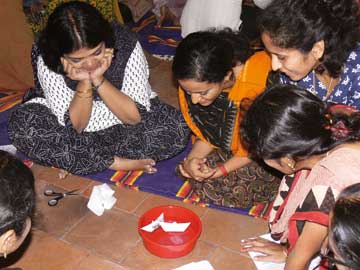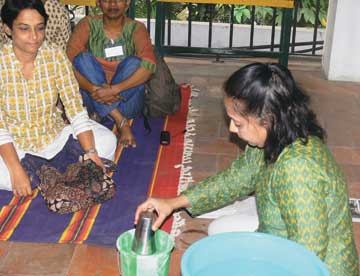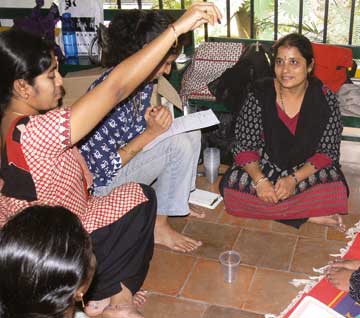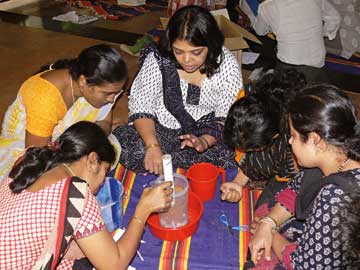Sonali Bhatia
Want to teach preschoolers science? Well, first, learn how to make yourself scarce! Yes, that’s right. Preschool science is best taught by a teacher who knows when NOT to intervene. “Children should be allowed to ask questions and find the answers themselves,” says Sheelu Rao (Founder – Center for Initiatives in Science and Environment Education), speaking to a group of preschool teachers at Sutradhar, Bangalore.
 Thus is born the concept of ‘Little Science’ – where youngsters play with everyday materials and discover scientific concepts independent of adult interference. “Each subject should hone different skills,” Sheelu explains. “There’s no point in teaching English in the same way as you teach Geography, for example. And confining Science teaching to the classroom, textbook, and laboratory greatly reduces the sense of wonder that a child of any age feels at scientific phenomena. Science is all around us, all the time and children should learn to explore constantly.”
Thus is born the concept of ‘Little Science’ – where youngsters play with everyday materials and discover scientific concepts independent of adult interference. “Each subject should hone different skills,” Sheelu explains. “There’s no point in teaching English in the same way as you teach Geography, for example. And confining Science teaching to the classroom, textbook, and laboratory greatly reduces the sense of wonder that a child of any age feels at scientific phenomena. Science is all around us, all the time and children should learn to explore constantly.”
So, how do you go about teaching science to children in the age group of 4 – 6 years? Follow these steps for a fun-filled, forward learning approach:
Decide the activity.
Discuss it with other adults responsible for the group, to determine possible cross-curricular links.
Conduct a discussion with the children to identify what they know about the topic on which the activity is based.
Collect supplies for the activity – these are everyday objects, easily available around the home or school. Identify specific areas in which children will need help with the materials or procedures (and while conducting the activity help them only with those!)
Try the activity yourself, think of possible questions you can ask to stimulate interest, and possible variations in the activity.
Create work-stations, where children can carry out the activity in small groups. Let them work as independently as possible.
Encourage children to predict, ask questions, and compare results to their predictions. Let them share their observations – but do not coax them if they are unwilling to speak up. Give each child the opportunity to try the activity, and remember to focus on the process skills and not the product.
After the activity, let children record their observations either pictorially or in writing, and apply what they have learnt to the science around them.
 Take the activity ‘Dry Paper’. You need a bucket of water, a glass and a wad of newspaper. Crush the newspaper and tuck it deep into the glass, so that it doesn’t fall out. Then, holding the glass straight, insert it upside down into the bucket. Ask the children to predict whether the paper is going to come out wet or dry. Once all children have stated their predictions, pull the glass out and take the paper out. Let the children feel the paper. Is it wet or dry? Could they predict the result accurately? Let the children conduct the experiment themselves. Ask them if they feel anything. They’ll feel the air inside the glass resisting their efforts to push, but the teacher should not tell them that this is what it is. Allow them to feel it and think for themselves, let them try variations like inserting the glass in slanting or right-side up. Try using a smaller glass, a bigger bucket and so on – changing only one variable at a time.
Take the activity ‘Dry Paper’. You need a bucket of water, a glass and a wad of newspaper. Crush the newspaper and tuck it deep into the glass, so that it doesn’t fall out. Then, holding the glass straight, insert it upside down into the bucket. Ask the children to predict whether the paper is going to come out wet or dry. Once all children have stated their predictions, pull the glass out and take the paper out. Let the children feel the paper. Is it wet or dry? Could they predict the result accurately? Let the children conduct the experiment themselves. Ask them if they feel anything. They’ll feel the air inside the glass resisting their efforts to push, but the teacher should not tell them that this is what it is. Allow them to feel it and think for themselves, let them try variations like inserting the glass in slanting or right-side up. Try using a smaller glass, a bigger bucket and so on – changing only one variable at a time.
 Another activity, ‘One Eye Power’ calls for a plastic cup and some coins. With his arm held at slightly above head level and both eyes open, the child tries to drop a coin into the plastic cup, which is placed on the floor at arms’ length. The activity is repeated with one eye closed, and the results are compared. Variations include marking objects, like a paper, and placing it on the floor, and trying to touch the mark with the coin, with one or both eyes open.
Another activity, ‘One Eye Power’ calls for a plastic cup and some coins. With his arm held at slightly above head level and both eyes open, the child tries to drop a coin into the plastic cup, which is placed on the floor at arms’ length. The activity is repeated with one eye closed, and the results are compared. Variations include marking objects, like a paper, and placing it on the floor, and trying to touch the mark with the coin, with one or both eyes open.
 ‘Making a Water Well’ helps children understand how rainwater percolates and reaches wells. The materials needed are – an empty paper towel roll, a large container, gravel, sand and a mug of water. While one child holds the empty paper towel roll in the container, another child places the gravel around the empty tube up to about half the height of the container. On top of the gravel, a child puts a thick layer of sand. Water is poured slowly into the container, and children observe how the water percolates. An interesting variation of this is to place a plastic bag in the sand, and observe its effects in the filling of the well. An environmental message learnt quickly and effectively!
‘Making a Water Well’ helps children understand how rainwater percolates and reaches wells. The materials needed are – an empty paper towel roll, a large container, gravel, sand and a mug of water. While one child holds the empty paper towel roll in the container, another child places the gravel around the empty tube up to about half the height of the container. On top of the gravel, a child puts a thick layer of sand. Water is poured slowly into the container, and children observe how the water percolates. An interesting variation of this is to place a plastic bag in the sand, and observe its effects in the filling of the well. An environmental message learnt quickly and effectively!
Want more? Try making boats with different types of paper, to find out which sinks first. Try rubbing different foods on to tissue paper, to determine the level of oil in the snack.
Above all – remember – science is all about curiosity, wonder, and endless exploration!
The author gave up a corporate career to become a librarian in a leading school in Bangalore. She now conducts workshops in literary topics for students, parents and teachers. She is interested in unique approaches to education and in writing about these. She can be reached at sonaliarun@gmail.com.
